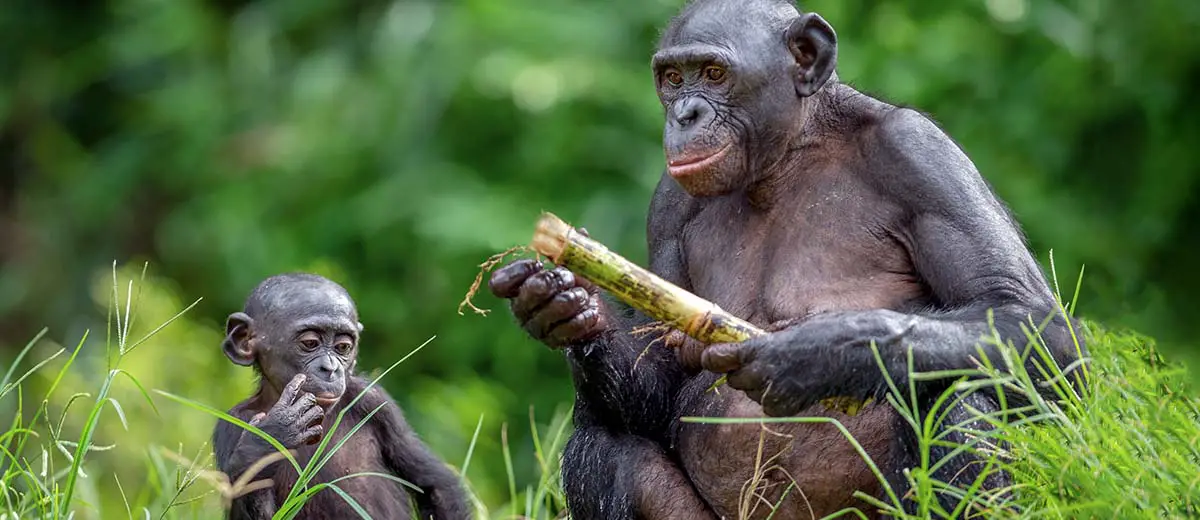Last Updated on June 3, 2024 by Annie Baldwin
Chimpanzees are incredibly intelligent primates that have evolved remarkable adaptations to thrive in the dense rainforests of Africa.
Their ability to swing through the trees, fashion tools, and problem-solve is unmatched in the animal kingdom.
Read on to learn more about how these fascinating apes have adapted to their natural habitat.
How Do Chimpanzees Adapt to Their Environment?

Chimpanzees have adapted to life in tropical forests through anatomical features like flexible wrists and fingers for climbing, strong jaws for eating tough foods, and keen senses to find ripe fruits and avoid predators.
They build tree nests for sleeping and use tools to acquire food.
Chimps also form complex social groups and communicate in sophisticated ways.
Their adaptability to varied conditions and ability to modify behaviors may aid their survival amid environmental changes.
Key Points
- Chimpanzees are adapted for climbing with long arms, flexible wrists, opposable thumbs and toes, and strong leg muscles.
- They build tree nests for sleeping and protection using branches, leaves, and twigs.
- Chimps use tools, have complex social structures, and communicate in advanced ways.
Our Opinion
Chimpanzees display remarkable adaptability that has enabled their continued existence in changing environments.
Their anatomical, behavioral, and intelligence adaptations allow them to thrive in forest and savanna habitats.
However, chimpanzee survival is threatened by habitat loss.
Their flexibility and ability to modify behaviors show potential for adapting to climate change and human encroachment if given protected habitats.
Understanding chimpanzee adaptations provides insight into protecting these amazing apes.
Chimpanzee Adaptations to Tropical Rainforests

Chimpanzees are perfectly suited to life in the tropical rainforests of Africa. Here are some of their key adaptations:
- Forelimb-suspensory locomotion – Their long arms allow them to brachiate, swinging from tree to tree by their arms.
- Opposable thumbs – Like sloths, they have thumbs that allow them to grasp branches and pick up objects with ease.
- Sharp senses – They have excellent vision, hearing, and sense of smell to spot food and threats.
- Large brains – Their advanced cognition helps them create tools and solve problems.
- Nest building – They build nests high up in trees using twigs, leaves, and branches to sleep safely at night.
Chimpanzees living in more open habitats like savannahs and grasslands must adapt to large temperature swings and changing vegetation. Those in fragmented habitats with human encroachment may cross roads and approach settlements in search of food within their home range.
Scientists like Dr. Alexander Piel of UCL Anthropology believe chimpanzees’ known adaptability to varied habitats may be key to their survival amid climate change. Individuals in variable conditions exhibit different behaviors and tool use, suggesting an ability to adjust.
Chimpanzee Locomotion and Opposable Thumbs

Chimpanzees are incredibly agile primates thanks to adaptations in their arms, legs, pelvis, and feet. Their long arms allow them to swing their bodies swiftly through trees in a style of locomotion called brachiation. This forelimb-suspensory locomotion lets them move efficiently to find food and build nests high in the canopy.
Chimpanzees also have flexible wrist and ankle joints that give them a wide range of motion. Their feet are specialized for grasping, with a large opposable toe that provides excellent grip. This, along with their opposable thumbs, allows chimpanzees to deftly pick fruit, grab branches, and fashion tools out of sticks and rocks.
These locomotive adaptations suit the chimpanzee perfectly to life in the complex branch networks of tropical rainforests. Their ability to swing, climb, and manipulate objects contributes to their success in harvesting difficult-to-reach food sources. This in turn enables extended parental care of offspring who benefit from their mothers’ foraging skills.
Chimpanzee Nest Building Skills
Chimpanzees build new nests to sleep in almost every night, constructing them high up in the trees out of branches, twigs, and leaves. This helps keep them safe from predators.
They exhibit complex nest-building techniques, weaving and knotting flexible branches together to form a stable platform. Researchers have documented regional variations in nest building, with chimps in some areas specializing in certain techniques like making pillows out of leaves.
Females without dependent offspring build more simple nests, while mothers create more elaborate, comfortable nests for their young. This highlights how nest construction provides protection and facilitates extended maternal care in chimpanzee societies.
Chimpanzee Communication Methods
Chimpanzees have complex communication skills that help them interact and share information. They use facial expressions, gestures, postures, and vocalizations to express a range of emotions and meanings.
For example, pant-hoots are loud calls that can communicate excitement, warn of danger, or attract mates. Softer hoos and grunts play a role in short-range interactions. Chimps embrace, kiss, and pat each other on the back during grooming, reconciling after fights, or when greeting friends.
They are able to modify their signals based on the intended recipient, such as using visual signals more with deaf individuals. Young chimps learn communication methods from their mothers and others in the community. Researchers continue studying the nuances of chimp communication to better understand their social relationships and cognition.
Chimpanzee Foraging and Hunting Techniques
Chimpanzees spend much of their day foraging for food. Their diet is similar to Gorillas, which mostly consists mainly of fruits, leaves, bark, nuts, seeds, and insects. They use their long arms, flexible wrists, and opposable thumbs to efficiently pick and peel fruits and dig up roots.
Chimps exhibit complex hunting behaviors, working together to surround and capture prey like monkeys. They fashion tools out of branches, twigs, and leaves to extract insects from nests or poke into tree hollows searching for honey. Chimps modify sticks to “fish” for termites and ants.
Research shows different chimp communities exhibit unique foraging customs passed down through observation and practice. This cultural variation points to chimps’ ability to adapt techniques to best utilize the resources in their local habitat. Their nimble hands, ingenuity, and cooperation allow chimpanzees to thrive in the wild.
FAQ
What Are Some Behavioral Adaptations of a Chimpanzee?
Chimpanzees have adapted behaviors like complex communication, tool use, and social hierarchies that help them survive in their environments. They use calls, gestures, and facial expressions to communicate. Chimpanzees also use sticks, rocks, and leaves as tools to acquire food.
What Environment Do Chimpanzees Need to Survive?
Chimpanzees thrive in tropical rainforests and wooded savannas. They need large areas of dense forest habitat with tall trees for nesting and foraging. Access to clean water sources is also essential.
Can Chimpanzees Survive in Cold Weather?
No, chimpanzees are not well adapted to cold climates. They have thin body hair and cannot survive prolonged exposure to temperatures below 50°F. Chimpanzees build nests high in trees which provide insulation, but cold weather and snow would threaten their survival.
How Do Chimpanzees Cool Off?
During hot weather, chimpanzees cool off by resting in shady areas and sleeping on cooler forest floors rather than in tree nests. They may also pant, spread out to lose heat, drink more water, and groom themselves to stay cool.
Conclusion
Chimpanzees have adapted in many ways to survive in their forest and savanna environments. Their bodies, behaviors, and intelligence allow them to thrive in the trees, forage for food, build nests, communicate, and use tools. Adaptations like opposable thumbs and strong limbs help chimpanzees grasp branches and access food sources. Chimpanzee adaptability has been key to their continued existence in changing habitats. Understanding how chimpanzees adapt to their environment can help protect these intelligent apes.
